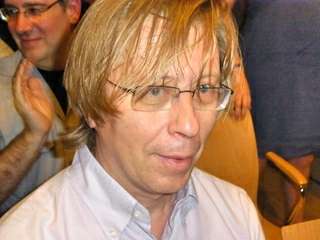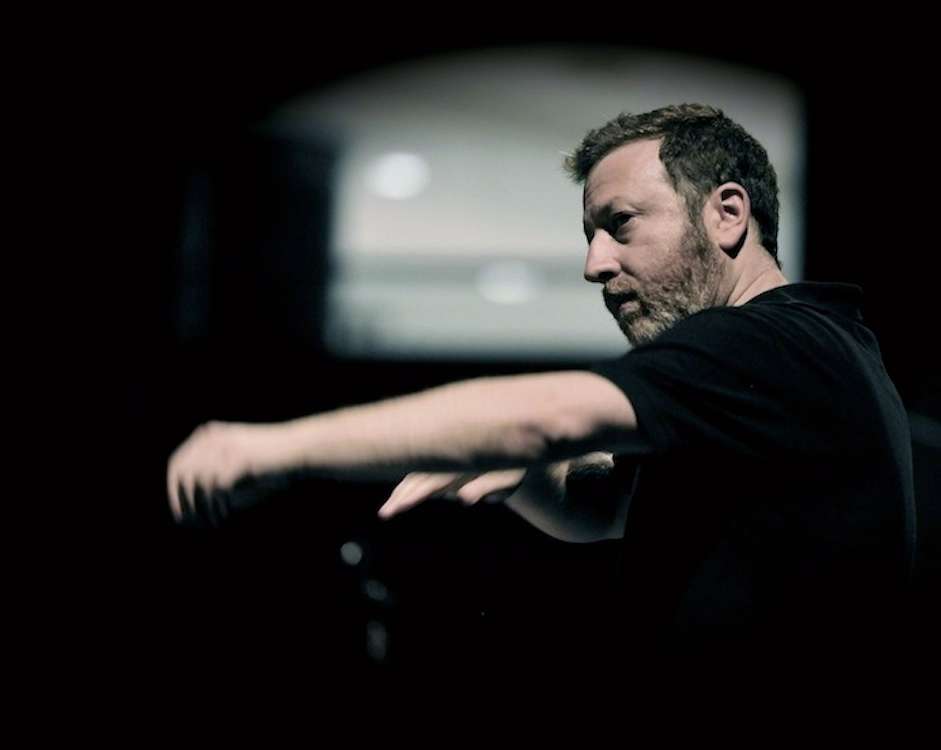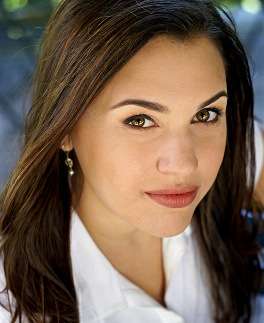|
Back
Visits to Various Universes New York
Miller Theater, Columbia University
10/10/2013 -
Georg Friedrich Haas: tria ex uno – de terrae fine – Atthis
Olivia De Prato (Violin), Rachel Calloway (Mezzo-soprano)
Ensemble Signal: Kelli Kathman (Flutes), Adrian Sandi (Clarinets), Brad Balliett (Bassoon), Nathan Koci (Horn), Bill Solomon (Percussion), Oliver Hagen (Piano), Olivia de Prato, Joshua Modney (Violins), Victor Lowrie (Viola), Lauren Radnofsky (Cello), Greg Chudzik (Bass), Brad Lubman (Conductor)

G. F. Haas (© Coco T. Dog)
A first hearing by Georg Friedrich Haas is like a first dish of oysters. The cerebral feelings are of alienation, illusions, horror The emotional reaction is Elysian joy, that one must–must!!–experience more of this so elusive feast.
My initial concert was the JACK Quartet playing Haas’ Third Quartet in total darkness. A week later, Alex Ross’s essay on Haas in The New Yorker was published. So transparent, clarifying and edifying were Mr. Ross’ words that I felt like Haas could be an old friend.
Except that this would have destroyed the extraterrestrial voyage of Haas music. For, as conductor Brad Lubman said last night in the Miller Theater “Composer Portrait” of Mr. Haas, “he takes us to a realm in which I had never been before.”
That is an understatement. The composer–once a luminary of the Spectral school and still influenced by microtones and overtones–is played with great frequency now. Much of this is because he has been appointed Professor of Composition in Columbia College, but more because we are enticed, mesmerized, even seduced into hearing these sounds.

B. Lubman (© bradlubman.me)
Mr. Lubman’s precision and enthusiasm led his Signal Ensemble in two works last night. The longest at 40 minutes was Atthis, which I heard originally with the Argento Ensemble. They were divided up with strings on one side, the winds and percussion on the other. Here, though, the orchestral integration allowed a sliding of colors around mezzo-soprano Rachel Calloway.

R. Calloway (© Claire McAdams)
Ms. Calloway herself took this impossibly difficult execution of glissandi, microtones, speaking, whispering and stratospheric high D’s with all the muscular technique necessary. But unlike the first soloist with the Argento, one was stunned by the purity of Ms.Calloway’s voice. That no matter what the hurdle, the emotion, the sexual thrill, one was astonished more by the virginal purity of the voice.
A second advantage last night was that the fragments of Sappho about her eponymous object of ardor were printed in the program. And while one would never wish to follow it through the performance, a reading showed what utter passion, what physical excitement were in the words.
Most important, Mr. Haas had taken these fragments, translating them into spoken German (or Greek), pushing the singer into a glissando of emotions, microtones and all. She could sing solo or gather the instruments around here. Her aloneness was shown in the floating last words of the first part, ”und dennoch” (“and yet...”) or in the fiery passion of the extended metaphor of a storm as sexual desire.
One feels guilty calling Mr. Haas a “romantic”, yet he never ever shies away from giving full feeling to the arousal, the frustration, the sexuality of the words.
More than a romantic, though, Mr. Haas can jolt us into sudden wormholes of time and space. During his “In the Dark” Third String Quartet by the JACK, we are suddenly, without warning given phrases from Carlos Gesualdo’s tenebrae of six centuries before. In Atthis, he has taken ancient Greek poetry.
In the second work of the program, de terrae fine (at the end of the earth), the solo violinist, Olivia De Prato, worked her way through mysterious bottom registers, luminous top notes, with (what seemed like) triple-stopped glissandi, we are again jolted, this time to a piece in perfect thirds which could have been written by Fritz Kreisler. Yet this sudden jump to quasi-kitsch has its reasons, since Mr. Haas takes these perfect thirds and almost unconsciously closes the harmonies until we have the same tune in microtonal thirds.
The recall of these measures brings now an image of Poe’s Pit and the Pendulum, being tightened in a vise, slowly being choked into a zero of feeling before being freed.
Ms. De Prato’s performance was one of unalloyed greatness. Yet, like all great actors, we weren’t so much impressed with her as with the art she gave us.

J. DesPrez (Anonymous portrait)
History was literally rewritten with the opening Tria ex uno (“one out of three”) based on the second Agnus Dei of the famous Josquin DesPrez mass. Here were three movements by the Signal Ensemble. First, a short re-orchestration of the original Medieval fragment, with the three lines all at different tempos. Second, a recognizable re-formation of the same harmonies, and lines.
The longest movement was the final one which, in Mr. Haas’ words, “is paraphrased, transferred and painted over.” Once again, Georg Friedrich Haas has transported us to another era, another time, with a brief stopover on October 10, 2013, before moving us into his ever-expanding, ever more intriguing micro/macro spatial/temporal multifarious assemblage of universes.
Harry Rolnick
|